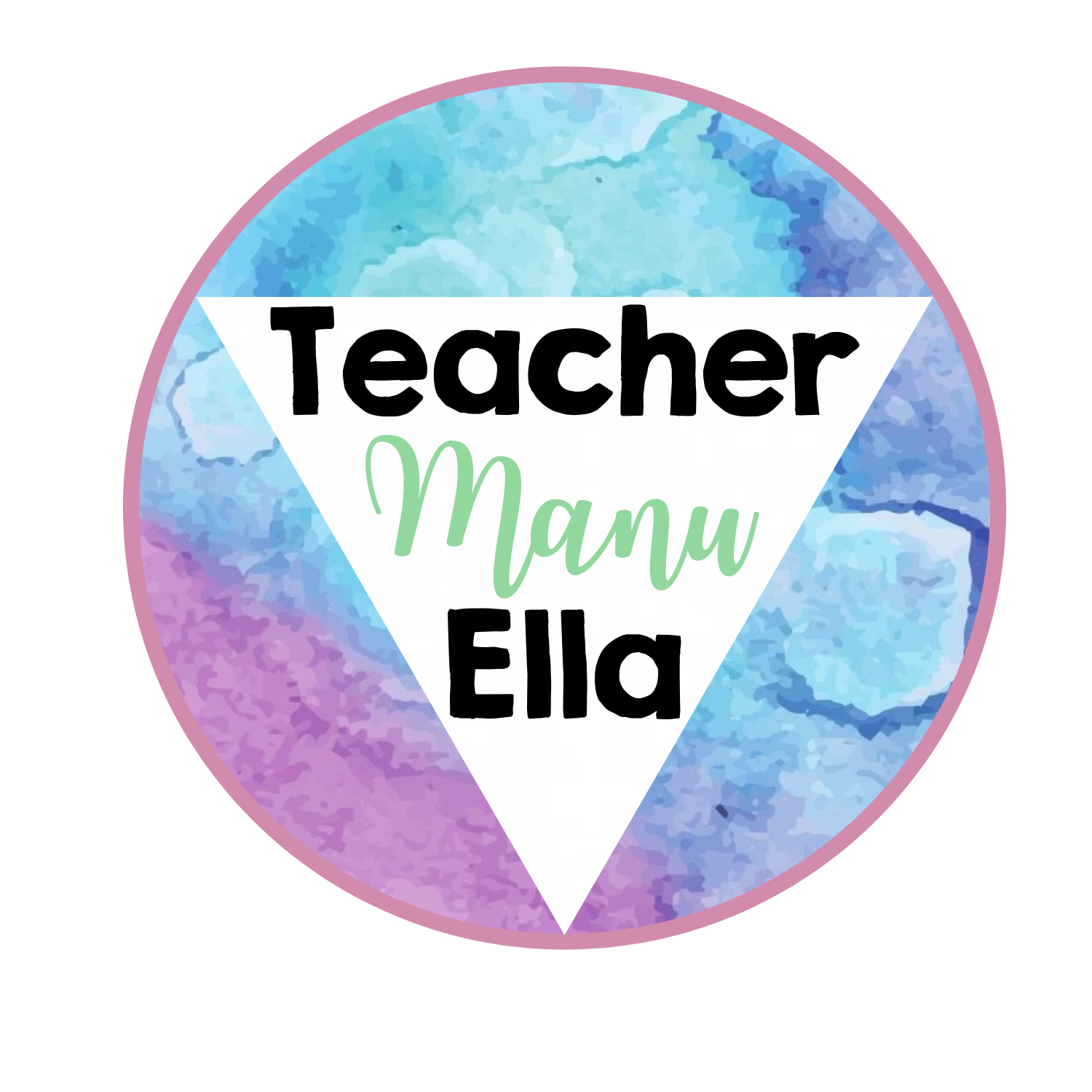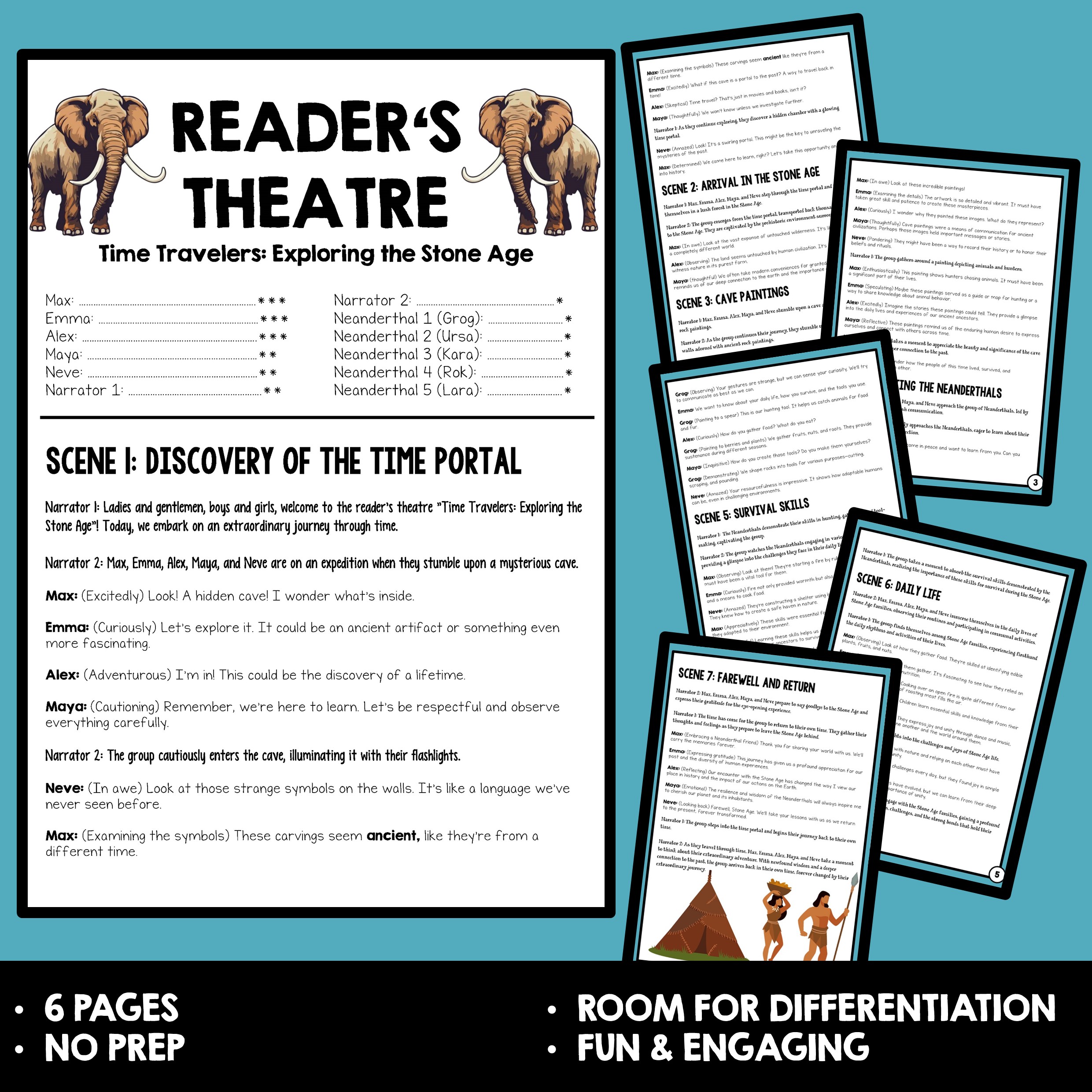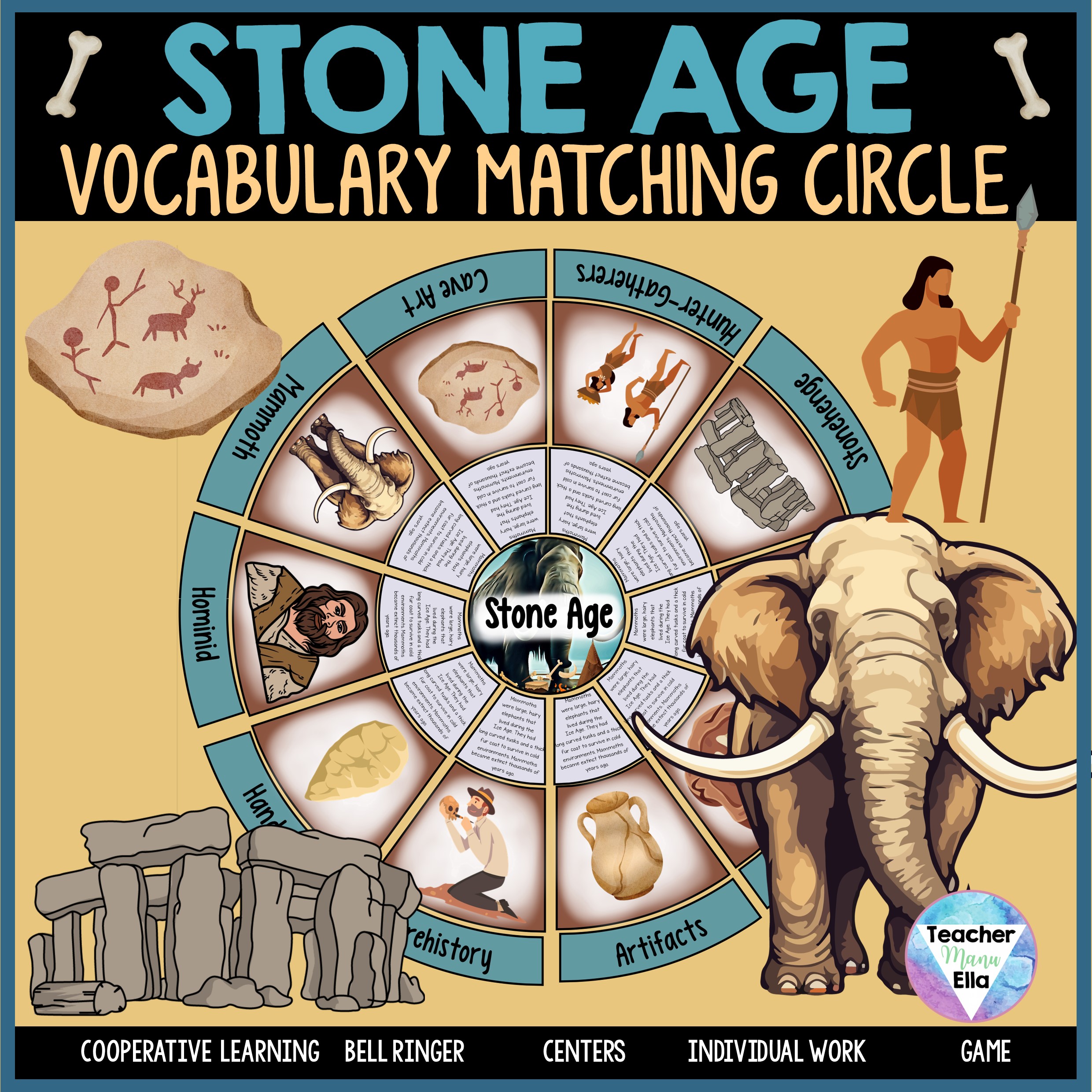Get ready to embark on an unforgettable adventure: exploring early humans for kids! Are you a teacher or parent looking for an exciting and impactful way to teach kids about the Stone Age and early humans? If so, join me on this unforgettable adventure! Together, we'll discover the perfect tools and strategies to make learning about this captivating realm of history engaging and enriching for your students or homeschooler. From mastering traditional tool-making techniques to exploring ancient artwork like the famous Lascaux cave paintings, this journey back in time is sure to ignite imaginations, expand perspectives, and encourage innovative thinking. So let's dive right in!
Step 1: Utilize free stone age lesson plans
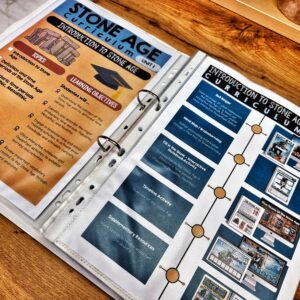
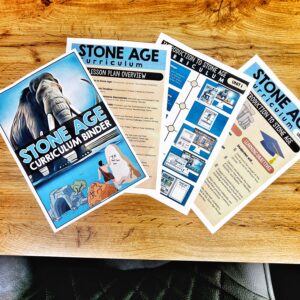
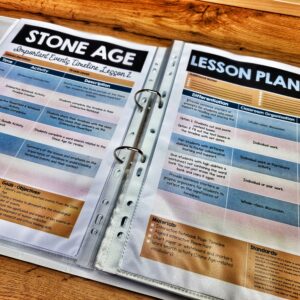
Harness the power of free Stone Age lesson plans to invigorate your teaching and enhance your students' learning journey. As educators, we understand the significance of well-structured, comprehensive resources that bring history to life in the classroom. However, finding high-quality, no-cost lesson plans isn't always easy.
That's why I'm excited to offer you a solution—a completely free set of 11 detailed unit lesson plans for Social Studies, covering approximately six weeks of engaging content. These plans encompass a wide array of topics, from laying out an Important Events Timeline and delving into Archaeology & Prehistoric Discoveries to unraveling the intricacies of Stone Age Tools and Skills, daily life during the era, and even Stone Age art and the Agricultural Revolution.
By utilizing these meticulously crafted lesson plans, you're not only saving precious preparation time but also ensuring that your students receive a comprehensive, immersive Stone Age education that sparks their curiosity and fosters a deep appreciation for history.
Step 2: Give A Brief Overview of the Stone Age
Establishing a strong foundation when teaching early humans for kids is essential to ensure that they develop a comprehensive understanding of this crucial aspect of our history. This foundation can be built by introducing them to key concepts such as the timeline of human evolution, the development of tools and language, and the ways in which early humans adapted to their environment. By providing a solid grounding in these fundamental principles, children can develop a deeper appreciation for the complexity and richness of our evolutionary history.

Why is this important?
Before we delve into the intricate details of our ancestors' lives, it's crucial to establish a clear understanding of the historical backdrop of human evolution. Introducing kids to the Stone Age offers them a unique perspective on the foundations of human civilization. Here's why this step matters:
Building Historical Context: Providing an overview of the Stone Age helps kids comprehend the immense stretch of time that humans have inhabited the Earth. This context aids in understanding the significance of early humans' achievements and adaptations and the impact they have on modern humans in the modern era.
Fostering Curiosity: Kids are naturally curious about the past and how humans lived before the modern world. Presenting a glimpse into the Stone Age ignites their curiosity, making them eager to learn more about our ancestors' lives.
Before modern technology, our human origins came from simple beginnings. The Stone Age has left an indelible mark on human origins, and our ancestors' innovations advanced through different periods. During this time, people evolved physically and mentally, adapting to their environment and inventing new technologies to solve the problems they encountered - the same way modern humans do in the modern era. Here is an overview of the Stone Age's three major periods: the Paleolithic, Mesolithic, and Neolithic.
The Paleolithic
Scientists and archeologists assume (mainly because of the study of fossils and other early human remains) that the Paleolithic period began three million years before Christ and lasted until the last ice age, around 10,000 B.C. This period is known as the Old Stone Age since the use of primitive stone tools and weapons characterized it. During this era, people lived in small nomadic groups, following their food sources from place to place. Cave paintings and carvings are the most famous examples of Paleolithic art, demonstrating that early humans were skilled artists. In terms of technology, early humans created sharp-edged stone tools, including hand axes, knives, and spearheads, and even discovered how to control fire.
The Mesolithic
The Mesolithic period began towards the end of the last ice age, and people entered the Middle Stone Age. By this time, humans had developed more advanced tools and weapons, including bone and antler weapons and fishing and hunting implements. With the disappearance of mammoths and other large animals, early humans shifted towards hunting and fishing for subsistence. This era also saw nomadic tribes in the Middle East, the first to domesticate animals and settle down into permanent abodes. These people were the first to develop farming, agriculture, and metalworking technology.
The Neolithic
Last but not least, the Neolithic period began around 10,000 B.C. and marked the end of the Stone Age. This period introduced humanity to the New Stone Age, characterized by the invention of agriculture, the domestication of animals, and the creation of permanent settlements. By this time, humans had learned to cultivate plants and raise animals for food and clothing, providing a surer and more stable source of food than hunting and gathering. This period also marks the beginning of the Bronze and Iron Ages, which sees the rise of civilizations and larger societies and their culture.
The study of human origins has fascinated scientists for centuries. One intriguing aspect of our evolutionary history is the existence of Neanderthals, a species known by their scientific name Homo Neanderthalensis. Scientists have extensively researched the relationship between Neanderthals and Homo sapiens, our own species.
Through the process of natural selection, our ancestors evolved to walk on two legs, becoming the upright man we are today. While other species, such as apes, share common ancestors with us, the fossil remains of Neanderthals provide valuable insights into our shared past. By analyzing these scientific remains, scientists can uncover clues about how Neanderthals lived, adapted, and ultimately, why they did not survive. The scientific exploration of human origins goes beyond mere speculation, relying on evidence and rigorous analysis to unravel the mysteries of our ancient past.
Step 3: Use A Diverse Range of Stone Age Activities
A variety of Stone Age activities is essential for kids because it caters to diverse learning styles, keeping students engaged and ensuring a well-rounded understanding of the subject. Different activities tap into different strengths – visual, auditory, and hands-on – making learning accessible and enjoyable for all. This mix also encourages critical thinking and creativity, fostering a deeper connection with Stone Age history.
Unlock the full potential of hands-on, comprehensive Stone Age activities that cater to diverse learning styles, harmoniously interconnect, and seamlessly integrate technology.
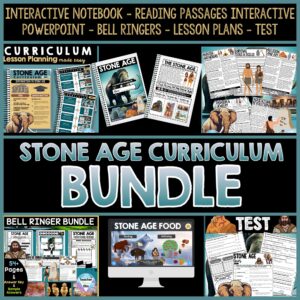
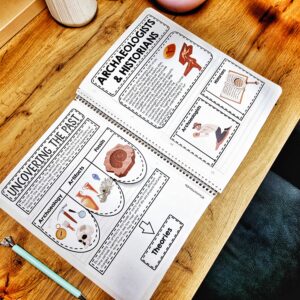

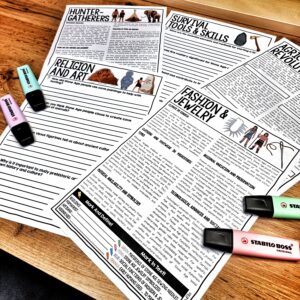
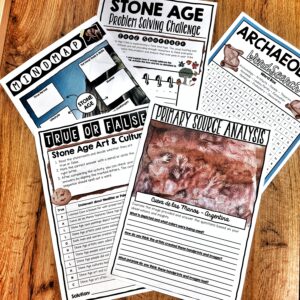
Introducing the Stone Age Curriculum BUNDLE — a dynamic 210+ page resource designed to revolutionize your teaching. At its core lies the Stone Age Interactive Notebook with an answer key, a true gem for its versatility and effectiveness.
Complementing this is an Interactive PowerPoint that not only aligns seamlessly with the notebook but also boasts an app-style structure, facilitating easy navigation for targeted learning.
But that's not all—discover five engaging reading passages with answer keys, 24 stimulating bell ringers featuring Mind Maps, Primary Sources, Word Searches, Creative Writing, Problem Solving Challenges, and True or False Activities. And for a comprehensive assessment, a Stone Age test with answer key awaits.
This complete package requires NO-PREP, empowering you to focus on sparking curiosity and driving meaningful learning experiences in your classroom. The Stone Age Curriculum BUNDLE isn't just a tool; it's a gateway to engaging, interconnected, and technology-enhanced education that makes history come alive for your students.
Step 4: Introduce a Stone Age Timeline
As we continue our journey into teaching early humans, the next crucial step is to introduce a Stone Age timeline. Just as a map guides explorers through unknown territories, a timeline provides a visual roadmap through the ages of our ancient past. This step allows young learners to grasp the chronological progression of the Stone Age, enhancing their comprehension and connecting them with the past in a tangible way. By tracing the footsteps of our ancestors across the Paleolithic, Mesolithic, and Neolithic periods, students gain insight into the changing landscapes of human existence. This interactive tool encourages them to actively engage with historical events and developments, fostering a deeper appreciation for the remarkable journey that has led us to the present day.

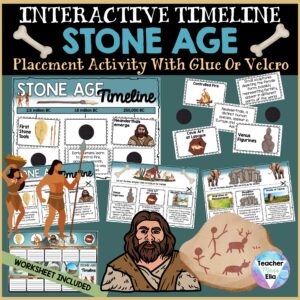
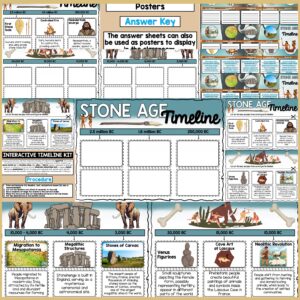
Pro-Tip: Combine Stone Age Education with Decor
I highly recommend incorporating an interactive Stone Age timeline, and here's why it stands out as an exceptional teaching tool. Imagine a hands-on activity where students become time-traveling detectives, placing picture boxes of significant events alongside their corresponding explanations using glue or Velcro. This approach seamlessly merges education with decor, offering a dynamic and immersive learning experience.
Educational Benefits
1. Engaging Hands-On Learning: The interactive timeline transforms the process of learning into an exciting hands-on adventure. Placing visuals and explanations side by side not only reinforces students' understanding of chronological order but also encourages them to actively participate in their learning journey.
2. Visual and Spatial Understanding: By manipulating images and arranging them along a timeline, students develop a visual and spatial understanding of historical progression. This tangible representation aids in comprehending the temporal relationships between events, fostering a deeper grasp of history.
3. Retention and Connection: When students physically place events and explanations, it creates a multisensory experience that enhances memory retention. This aids in building connections between different periods, enabling students to perceive patterns and the evolution of human society.
4. Decorative Learning: The interactive timeline isn't just an educational tool; it's a decorative addition to your classroom or home environment. As students engage with the timeline, it becomes a captivating display that ignites curiosity and prompts discussions, creating a unique learning atmosphere.
5. Collaborative Learning: When affixed to the wall within the classroom or at home, the timeline becomes a focal point for collaborative exploration. Students can discuss, compare, and analyze events together, fostering a sense of shared discovery and understanding.
This immersive journey goes beyond traditional classroom activities. The timeline is divided into significant sections, each illustrated with images and texts about early humans, human origins, and the human evolution that happened over the span of million years.
By introducing this interactive Stone Age timeline, you're providing students with an innovative and engaging platform to dive into history. As they piece together the puzzle of our past, they're not only learning about early humans but also cultivating essential skills like critical thinking, collaboration, and visual analysis. This distinctive approach ensures that learning about the Stone Age becomes an unforgettable adventure that leaves a lasting impact.
Contents You Should expect: From Nomads to Settlers & The Dawn of Civilization
A top-tier Stone Age timeline should vividly depict the evolutionary milestones of our early human ancestors, guiding students through their journey.
Now, imagine enhancing this experience with my unique interactive timeline. This hands-on tool allows your students to actively chart history: from the roaming footsteps of nomadic hunters to the settled communities birthed by Homo sapiens' innovative skills.


They'll learn when early humans wielded fire, crafted essential tools, and expressed themselves through intricate cave art. Moreover, the timeline dives into the Neolithic Revolution, showcasing when humanity's monumental shift towards agriculture and civilization took place. As they align picture boxes and explanations, students will journey to Mesopotamia, where iconic structures like Stonehenge and the Carnac stones await, reflecting the grandeur of our shared past. With this timeline, history isn't just taught; it's experienced.
The timeline will undoubtedly be a fantastic addition to any teacher's teaching toolkit and a great way to explore the fascinating and complex history of humankind.
Step 5: Focus on how our ancestors were surviving the Stone Age
As teachers, our goal is to immerse students in the challenges our ancestors faced and the ingenious ways they adapted.
Guide them with questions & Mind Maps
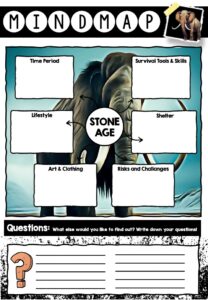
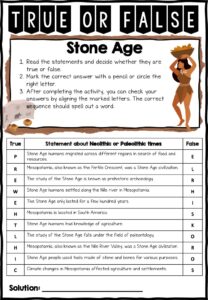

You can guide them with questions like "Imagine navigating the Stone Age with no Wi-Fi or Grubhub" or "How do you think early humans in the Stone Age found food? What methods and techniques might they have used for hunting and gathering?" Mindmaps and True or False Activities are also a great way to record and test the student's knowledge. The realities were harsh and primitive. Extreme climates and resource scarcity posed significant challenges for early humans. Yet, their resilience and creativity knew no bounds. They adapted by utilizing ingenious strategies to overcome environmental obstacles.
Create challenges that ignite their imagination
Here it is important to delve into how early humans tackled climatic shifts, using their innate skills and innovations. Kids thrive on imagination, and we can harness this by encouraging them to step into the shoes of our ancient counterparts. Let them brainstorm strategies for thriving in different environments, igniting their creativity as they devise solutions for hunting, shelter, and more. Engaging challenges that mirror our ancestors' quests for sustenance and safety not only offer a sense of adventure but also cultivates critical thinking and problem-solving abilities.
Pro-Tip: utilize the power of 24 bell ringers
In this Stone Age 24 Bell Ringer Bundle, there is a wide variety of activities available for students. These activities include problem-solving, mind maps, true or false quizzes, word searches, and primary source analysis. The bundle includes 24 bell ringers that are designed to engage students and promote active learning.
Provide opportunities for crafting tools, simulating hunting, and building shelters
Imagine students crafting tools from found materials, simulating ancient hunting methods, and constructing shelters reflective of the diverse climates our early humans encountered. These hands-on experiences are not only completely free, but breathe life into history, creating a bridge between the past and present. Moreover, this approach kindles empathy, helping students appreciate the incredible adaptability of our forebears.
Incorporate storytelling & role plays
Here it is important to delve into how early humans tackled climatic shifts, using their innate skills and innovations. Kids thrive on imagination, and we can harness this by encouraging them to step into the shoes of our ancient counterparts. Let them brainstorm strategies for thriving in different environments, igniting their creativity as they devise solutions for hunting, shelter, and more. Engaging challenges that mirror our ancestors' quests for sustenance and safety not only offer a sense of adventure but also cultivate critical thinking and problem-solving abilities.
Incorporating storytelling sessions around campfires, role-playing scenarios of survival, or even embarking on outdoor expeditions can further enrich this learning journey. A fantastic way to achieve this is by utilizing the ready-to-use Stone Age Readers' Theatre.
A Readers' Theatre is an interactive and engaging activity that involves students performing a script by reading it aloud instead of memorizing lines. This activity promotes reading fluency, comprehension, and creativity in a fun manner. The 6-page adventure is intended to ignite the imagination of young readers and inspire a passion for reading and storytelling.
Short on time? Grab teaching resources that are ready to go!
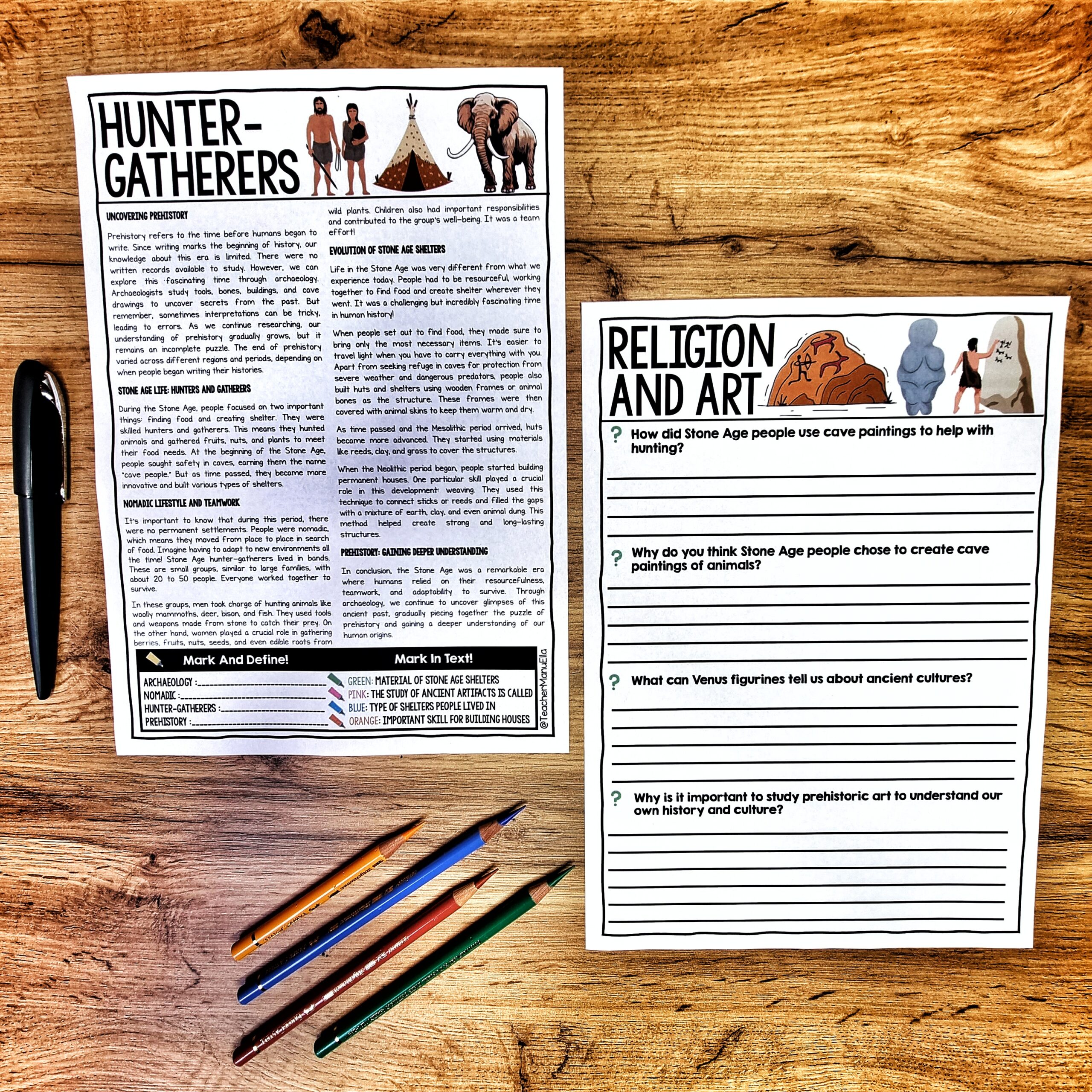
My "Stone Age Reading Passages & Worksheets", offers a peek into the lives of our resilient ancestors. One passage, in particular, discusses the importance of mastering Stone Age tools such as fire, hand axes, and specialized tools for hunting and fishing. Get ready to appreciate the innovative survival skills of early humans and their ability to thrive in the face of adversity.
Also included in my "Stone Age and Early Humans Bell Ringer Bundle" is a resource focused on surviving the Stone Age. It transports students back to the challenges and triumphs of our early human ancestors, engaging them through captivating scenarios such as food shortage, shelter innovation, and tool invention. Each bell ringer activity presents a unique challenge, fostering critical thinking, teamwork, and creativity. This comprehensive bundle offers a dynamic and immersive learning experience, igniting curiosity and inspiring a love for history and problem-solving in the classroom.

Step 6: Discover Prehistory Through more than just one Stone Age Game
Incorporating multiple games into your Stone Age curriculum isn't just about fun—it's about tapping into an essential aspect of how children learn. Games serve as immersive portals that transport students directly into the prehistoric past, allowing them to experience the challenges, triumphs, and daily lives of our early human ancestors firsthand.
By engaging in interactive activities, kids absorb historical concepts in a dynamic way, enhancing their retention, critical thinking, and teamwork skills. Games provide a fun and interactive learning experience, allowing children to immerse themselves in the fascinating world of the Stone Age.
Implement Stone Age Games & Brain Breaks
Through play, we provide a unique avenue for students to comprehend the intricacies of prehistory. Games captivate their attention and encourage active participation, making complex historical concepts more digestible and enjoyable.

As an educator, I created the Stone Age Games & Brain Breaks Bundle, a thoughtfully crafted teaching resource tailored for upper elementary and middle school students. This bundle includes four exciting products, including a Stone Age Board Game, Stone Age Vocabulary Matching Circle, Stone Age Taboo Game, and Stone Age Readers' Theatre.
Incorporate a Stone Age Board Game
Board games offer a dynamic and immersive approach to teaching the Stone Age and early humans. By engaging tactile and strategic thinking, board games provide students with a tangible understanding of prehistoric life, simulating challenges our ancestors faced.
These games promote critical thinking, teamwork, and social skills, all while contextualizing historical knowledge in interactive scenarios. Through repeated plays, students solidify their understanding, making learning an engaging and continuous process.
Ultimately, board games seamlessly merge education and entertainment, making the exploration of the Stone Age an unforgettable and educational adventure for students.
Get a Game-Changing Tool for Busy Educators at a Low Cost
Elevate your Stone Age teaching effortlessly with this "Stone Age Board Game." No prep needed – it's ready to print and play! This one-page wonder is budget-friendly (only $1.99) and eco-conscious, offering questions on the front and answers on the back. It's the ultimate test-prep tool and a fun way to review learned material. Simply print, maybe laminate, provide a timer, and let the excitement unfold in your classroom. Get your students engaged while you save time – that's a win-win!
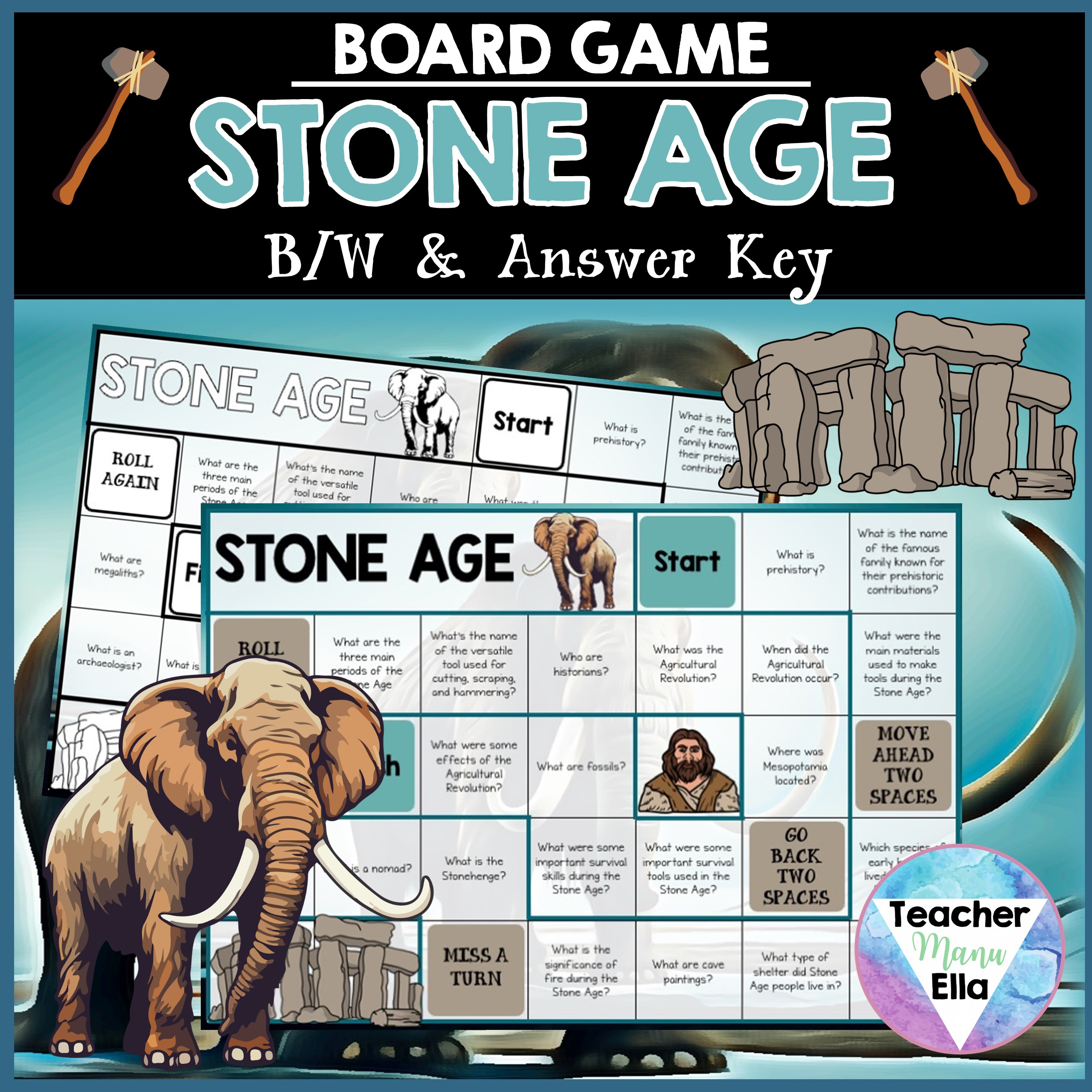
Include Vocabulary Games and Activities
Incorporating vocabulary games and activities is a strategic move that enhances the learning experience in various ways. Firstly, it introduces an element of fun and engagement, making the learning process more enjoyable for students. Vocabulary games provide a context for language acquisition, allowing students to grasp words and their meanings in a practical setting. Additionally, these games encourage active participation, boosting memory retention and reinforcing newly learned terms.
Why use a Vocabulary Matching Circle Montessori-Style
Elevate your teaching with the Stone Age Game - Vocabulary Matching Circle Montessori Style, a unique educational resource that infuses vocabulary learning with excitement and hands-on exploration.
As students match terms, pictures, and explanations to form a circle around the center, they actively engage with the material while aligning seamlessly with Maria Montessori's philosophy of promoting independence, curiosity, and love for learning.
This interactive game transforms dry vocabulary drills into a captivating adventure, fostering comprehension, critical thinking, and memory retention. By incorporating this innovative tool, you're creating a dynamic classroom environment where history comes alive through self-paced discovery, igniting students' passion for early human history and vocabulary acquisition.
Each game is meticulously curated to entertain and educate, offering creative role-plays, challenging problem-solving scenarios, and exciting team-building exercises. Through these games, students will not only have a blast but also gain a deeper understanding of the Stone Age and its significance in human history.
Step 7: Explore Stone Age Art through Cave Paintings and Stone Age Jewellery

Delve into the captivating world of prehistoric art as you guide your students through the mesmerizing realm of cave paintings and Stone Age jewelry. These remarkable artifacts offer windows into our ancestors' lives, igniting curiosity and fostering a deeper connection to history. As a teacher, you have the opportunity to transport your students back in time, allowing them to explore the intricate designs and symbols that adorned cave walls and the exquisite craftsmanship of ancient jewelry.
Virtual Field Trip To Lascaux Cave
To enhance this immersive experience, consider organizing a virtual field trip to the renowned Lascaux Caves, where students can virtually wander through the intricate drawings that have survived thousands of years.
The "Lascaux Caves Virtual Tour" website, created by experts in collaboration with archaeologists, offers teachers and students a captivating, free virtual field trip to the renowned Lascaux Caves. This unique online resource enables exploration of intricate prehistoric cave paintings, providing an immersive experience that brings history to life right in the classroom.
Engaging in discussions, hands-on activities, and creative projects inspired by these ancient treasures can turn history into a vibrant learning adventure.
Step 8: Study Ancient Monuments with a Prehistory Map
Maps are invaluable tools for education, offering visual insights into geography and history. They are particularly useful for tracing the movement and migration patterns of early humans, helping students understand how landscapes influenced their journeys. By analyzing maps, students can uncover how geography shaped migration routes and settlement patterns, providing a tangible link to the past.
In order to make the journey accessible and engaging for your students, it's helpful to use tools such as physical maps that can be hung up in the classroom, online maps, and digital platforms. Encourage your students to do research through already prepared reading passages, conducting their own internet research, or providing them with magazine articles.
Elevate your teaching with the Stone Age Monument Map
This educational gem that offers a multifaceted learning experience while enhancing your classroom decor. This comprehensive Stone Age Monument World Map, spanning 10 pages, empowers students to explore early human history by placing monumental landmarks in their rightful locations. It's not just an engaging activity; it's an opportunity to deepen their understanding of geography, history, and the monumental achievements that shaped our past.
Pair the map with the Stone Age Monuments Posters
But the learning doesn't stop there. Pair the map with our Stone Age Monuments Posters featuring Göbekli Tepe, Stonehenge, Newgrange, and the Carnac Stones.
These collaborative posters are not only captivating eye-catchers but also powerful learning tools. Each monument poster comes with an informational text—an in-depth reading passage spanning two pages, delivering all the essential details needed to complete the poster. This inclusion transforms this resource into a seamless no-prep solution, allowing you to focus on guiding students through history-rich discussions and activities.
Step 9: Take Advantage of Stone Age Facts and Trivia
Uncover the captivating world of the Stone Age through our collection of intriguing facts and trivia. Immerse yourself in the remarkable technological advancements achieved by our ancestors, from the mastery of crafting essential tools such as hand axes to harnessing the transformative power of fire.
Explore the vibrant cultural practices that shaped their daily lives, from the mesmerizing cave paintings and enchanting Venus figurines that unveiled their artistic inclinations to the nomadic lifestyle they embraced. With captivating trivia and enchanting anecdotes, we breathe life into history, captivating young minds in an immersive learning experience they will forever cherish.
How to use Stone Age Facts and Trivia in your Classroom?
Teachers can use stone age facts and trivia information to engage students in history lessons by organizing interactive quizzes or trivia games. They can also incorporate these facts into hands-on activities, such as creating models of stone age tools or organizing a mock archaeological dig, to help students better understand the daily lives and challenges of stone age people. Teachers can also create trivia questions based on stone age facts and challenge students to answer them individually or in teams. They can also organize a "Stone Age Jeopardy" game where students compete by answering questions related to different aspects of the stone age. Additionally, teachers can provide students with stone age fact cards and ask them to match the facts with corresponding images or artifacts, promoting critical thinking and engagement with the material.
Using my Stone Age Word Wall, which was specifically designed for this purpose, can greatly enhance the effectiveness of this method. Students are required to attach 20 definitions to the vocabulary sheets and match them with the corresponding images. This approach not only encourages critical thinking and improves vocabulary retention, but also serves as a decorative educational tool.
Step 10: Use Stone Age Movies to Bring History to Life
Movies have the power to transport us to different eras and immerse us in captivating narratives. When it comes to the Stone Age and Early Humans, filmmakers have taken on the challenge of bringing this ancient period to life on the big screen. Through these movies, we can catch a glimpse of what life might have been like for our early human ancestors.

One notable film is "Quest for Fire" (1981), which follows a group of early humans on a perilous journey to find fire. This movie not only showcases the harsh realities of survival in the Stone Age but also highlights the importance of fire in our ancestors' lives.
Another intriguing film is "10,000 BC" (2008), which depicts a young hunter's quest to save his tribe from an ancient civilization. While the movie takes some creative liberties, it offers an entertaining adventure set in the prehistoric world.
For a more animated experience, "The Croods" (2013) provides a family-friendly take on the Stone Age, following the adventures of a caveman family as they navigate a changing world. These movies, among others, allow us to explore the Stone Age and gain a deeper appreciation for our ancient ancestors' struggles and triumphs.
Step 11: Introduce The Stone Age Hand Axe And Other Tools And Skills
During the Stone Age, early humans relied heavily on their ingenuity and resourcefulness to survive in a harsh and unforgiving world. One of the most significant tools they crafted was the hand axe, a versatile and essential tool that served a multitude of purposes.
This simple yet effective stone tool was used for cutting, chopping, and shaping various materials, making it a crucial asset for hunting, building shelters, and preparing food.
The hand axe's sharp edge allowed early humans to efficiently process animal hides, fashion wooden spears, and even create fire. Its versatility and durability made it a staple in the toolkit of our ancestors, enabling them to adapt and thrive in their environment. Today, we can still marvel at the craftsmanship and innovation behind the hand axe.

In my Stone Age Interactive Notebook, I have created an engaging activity where kids can match survival tools and skills with corresponding pictures. This hands-on approach allows children to delve deeper into the world of Stone Age tools and gain a better understanding of the importance of these tools for survival, innovation, and advancement during the Stone Age.
Step 12: Explore the Past with Stone Age Books
Elevate your learning journey by immersing students in the rich world of early humans through recommended books that vividly bring the Stone Age to life. Books are powerful tools that allow young minds to journey back in time, exploring the triumphs and challenges of our ancestors. They provide a comprehensive understanding of prehistoric times, from the everyday lives of early humans to the cultural and technological advancements that shaped their world. Here are 10 highly recommended books suited for kids aged 9-14 that will ignite their curiosity and foster a deep appreciation for the Stone Age:
"Stone Age Boy" by Satoshi Kitamura
"The First Drawing" by Mordicai Gerstein
"Boy of the Painted Cave" by Justin Denzel
"Wolf Brother" by Michelle Paver
"Clan of the Cave Bear" by Jean M. Auel
"The Secrets of Stonehenge" by Mick Manning and Brita Granström
"The First Dog" by Jan Brett
"The Chronicles of Ancient Darkness" series by Michelle Paver
"Stone Age: The Essential Guide to Prehistoric Britain" by Jacqui Wood
"The Stone Age" by David Macaulay
These books serve as captivating companions to your curriculum, offering a literary voyage that deepens understanding while igniting imaginations. Through the pages of these carefully selected titles, students will not only learn about the Stone Age but also form a meaningful connection to the past that stays with them long after the final chapter.
Step 13: Uncover Early Humans Shelter and Survival Techniques
For educators seeking actionable tips to enrich their curriculum, consider immersing students in the captivating world of early humans by exploring their ingenious shelters and survival techniques. Here are five engaging strategies to bring this history to life:
- Shelter-Building Workshops: Organize hands-on workshops where students work collaboratively to design and construct mini shelters using natural materials. This kinesthetic activity fosters teamwork, problem-solving, and an appreciation for the resourcefulness of early humans.
- Fire-Starting Simulations: Demonstrate the significance of fire mastery by guiding students through fire-starting simulations. Incorporate historical context by discussing how early humans used fire for warmth, cooking, and protection. This experiential approach enhances their understanding of survival skills.
- Tool-Making Demonstrations: Offer demonstrations on crafting Stone Age tools like hand axes or simple cutting tools. Provide students with raw materials and step-by-step instructions to recreate these tools themselves. This hands-on experience sheds light on the innovation behind everyday tools.
- Outdoor Survival Challenges: Organize outdoor challenges where students apply survival techniques in simulated scenarios. From finding edible plants to building rudimentary shelters, these activities encourage critical thinking and allow students to experience the practicality of early human strategies.
- Prehistoric Shelter Models: Introduce a creative element by assigning students the task of designing and building models of prehistoric shelters. Encourage them to consider environmental factors, available resources, and adaptability. This project blends history with art, offering insights into the symbiotic relationship between humans and their surroundings.
By integrating these strategies, you not only cultivate a comprehensive understanding of early human life but also nurture essential life skills and a deep appreciation for our ancestors' resilience.
Conclusion
I hope this comprehensive "How To Teach Early Humans for Kids" guide has been a valuable resource for you in bringing the Stone Age to life for your students. As you've delved into various strategies, activities, and resources, I encourage you to reflect on your experiences so far.
Have you already introduced a Stone Age overview, explored the timeline, or engaged students with hands-on activities? Are there specific challenges or triumphs you'd like to share with your fellow educators?
Feel free to leave your thoughts in the comments below—whether it's about what you've implemented, your plans for the future, or any exciting outcomes you've observed. Your insights and experiences are invaluable and contribute to a dynamic community of educators dedicated to fostering a love for history and a passion for learning in young minds. Let's continue this journey together!
